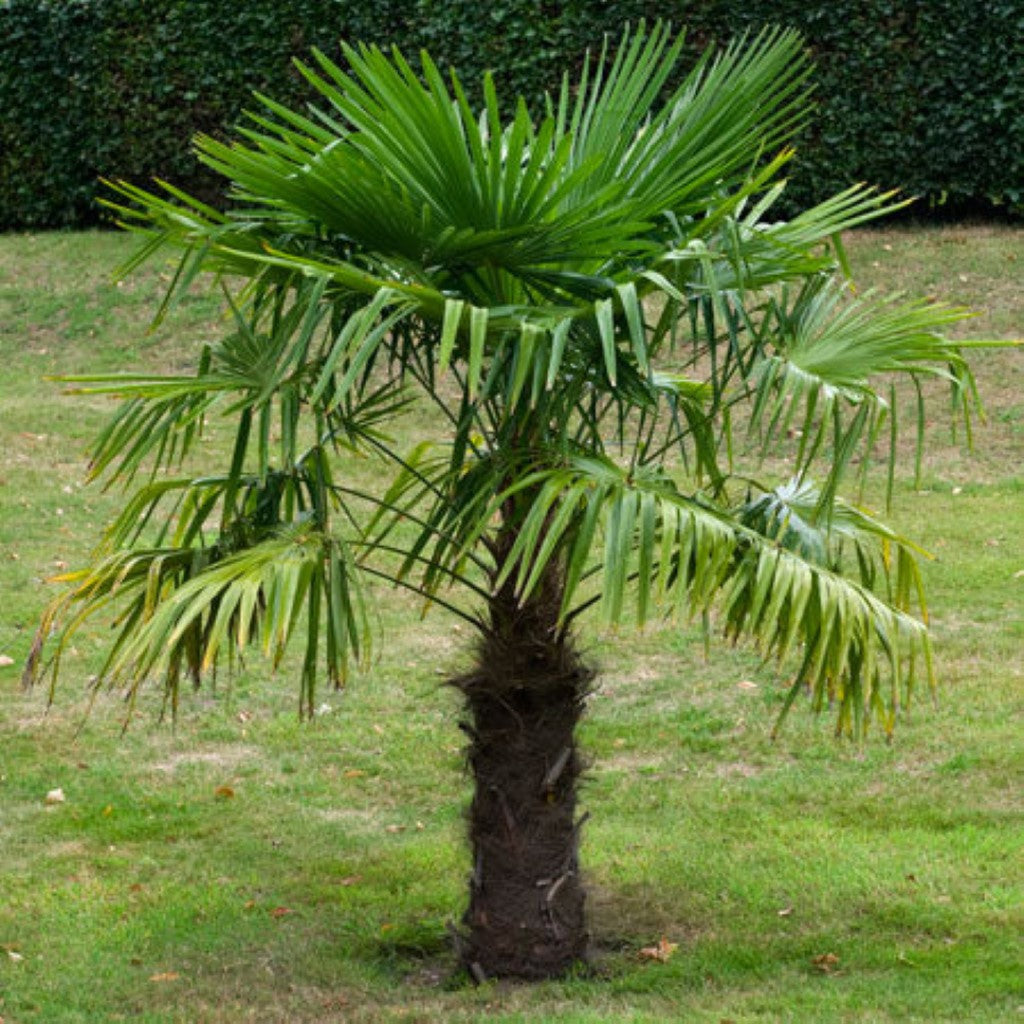You've come to the right place! Pixies Gardens is an online store where you can browse our extensive selection of palm trees 🌴 from the comfort of your home and have them delivered directly to your doorstep.
We offer a variety of palm tree species 🥥 to suit your preferences and climate. Trust our team of experts to guide you in selecting the perfect palm tree for your garden. Have a look at our palm trees for sale today and get the best bang for your buck with Pixies Gardens!
📖 History & Origin
Palm trees have a rich history dating back millions of years. Originating in the tropical regions of the world, palm trees belong to the family Aceraceae, encompassing over 2,500 species.
Throughout history, palm trees have been celebrated for their resilience, beauty, and versatility. The date palm 🌴 held immense cultural and economic importance, serving as a source of food, shelter, and materials for construction.
🌳 Optimal Conditions for Cultivating Palm Trees
Palm trees do not have a specific harvest season like fruit-bearing trees. Instead, they are ornamental plants prized for their foliage and overall appearance.
|
Parameter |
Details |
|
Family |
Arecaceae (Palm family) |
|
Growth Habit |
Evergreen tree or shrub |
|
Height |
Varies widely by species, from a few meters to over 30 meters (100 feet) |
|
Lifespan |
Varies by species, some can live for centuries |
|
Hardiness Zones |
Varies by species, many tropical and subtropical species |
|
Temperature (F) |
Generally tropical to subtropical climates, with optimal temperatures typically between 70°F to 90°F (21°C to 32°C). Some palm species can tolerate occasional frosts, while others are sensitive to cold temperatures. |
|
Soil Requirements |
Well-drained soil, prefers sandy or loamy soil |
|
pH Range |
Typically prefers slightly acidic to neutral soil pH (6.0 to 7.0) |
|
Sun Exposure |
Full sun to partial shade |
|
Watering Needs |
Generally moderate to high water requirements, especially during periods of active growth |
|
Pruning Requirements |
Minimal pruning for maintenance and removal of dead fronds |
|
Flowering Season |
Varies by species, some palms produce flowers throughout the year |
|
Flower Color |
Varies by species, often small and inconspicuous |
|
Fruit Ripening Season |
Varies by species, often in late summer to fall |
|
Fruit Color |
Varies by species, can be black, red, yellow, or orange |
|
Fruit Flavor |
Varies by species, ranging from sweet to bitter |
|
Propagation Methods |
Seeds, division, or tissue culture |
|
Pests and Diseases |
Vulnerable to various pests and diseases including palm weevils, scale insects, and fungal infections |
|
Harvesting Time |
Fruits are harvested when ripe, typically by hand |
|
Fertilizer Information |
Palm-specific fertilizers or slow-release fertilizers with a balanced N-P-K (nitrogen, phosphorus, potassium) ratio, applied according to label instructions. Avoid fertilizing directly onto the trunk to prevent damage to the tree. |
These trees have evolved very much over the years; they are capable of adapting to different climates and environments, from rainforests to deserts. Check out our live palm trees for sale now!
💮 Additional Characteristics and Information
- Diversity: There are over 2,500 species of palm trees, ranging from small shrubs to towering trees. Each species has its own unique characteristics in terms of size, shape, foliage, and growth requirements.
- Uses: Palm trees have numerous uses including landscaping, providing shade, producing edible fruits (such as dates and coconuts), and yielding valuable products like palm oil and palm sugar.
- Ecological Importance: Palm trees play crucial roles in their native ecosystems, providing habitat and food for various wildlife species. They also help stabilize soils and regulate local climates.
- Adaptations: Palm trees have evolved various adaptations to thrive in diverse environments, including specialized root systems for anchoring in sandy soils, and unique leaf structures for conserving water.
- Coconut Palms: Among the most famous palm species is the coconut palm (Cocos nucifera), known for its tall stature, graceful fronds, and versatile coconut fruits used for food, oil, and other products.
- Maintenance: Palms require regular maintenance including watering, fertilizing, and occasional pruning to remove dead or damaged fronds. Over-pruning or incorrect pruning practices can harm the tree.
- Cold Tolerance: While many palm species are tropical or subtropical, some are surprisingly cold-hardy and can tolerate freezing temperatures for short periods with proper care.
- Environmental Impact: Some palm species are threatened by habitat destruction, over-harvesting, and invasive pests and diseases. Conservation efforts are underway to protect vulnerable palm populations.
☀️ How to Grow Palm Trees in Your Garden/Orchard?
Cultivating palm trees is not easy, but with our real palm trees for sale and the instructions below, you can grow a few of your own!
- Selecting the Right Species: Choose palm tree species suited to your climate, considering factors like cold hardiness and drought tolerance.
- Site Assessment: Evaluate your garden or orchard for adequate sunlight, soil drainage, and space to accommodate the mature size of palm trees.
- Soil Preparation: Prepare the soil by incorporating organic matter and ensuring it is well-draining to prevent waterlogging, which can lead to root rot.
- Planting Technique: Dig a hole slightly larger than the palm's root ball and backfill with soil, ensuring the trunk is at the same level as it was in the container.
- Watering Regimen: Provide regular watering, especially during the establishment period, and adjust frequency based on weather conditions to prevent drought stress.
- Fertilization Schedule: Apply a balanced palm fertilizer according to package instructions to provide essential nutrients for healthy growth.
- Mulching: Apply a layer of organic mulch around the base of the palm tree to conserve moisture, suppress weeds, and regulate soil temperature.
- Pruning Practices: Prune dead or damaged fronds and flowers as needed, but avoid excessive pruning, as palms rely on their fronds for photosynthesis.
- Pest and Disease Management: Monitor for common palm pests like palm weevils and scale insects, and promptly treat infestations using appropriate methods.
- Protection from Frost: In regions prone to frost, protect palm trees during cold spells by covering them with frost cloth or wrapping the trunk with insulation.
✨ Our Best-Selling Palm Trees (Species)
Have a look at our varied selection of top-selling palm trees for sale near you at Pixies Gardens. We have all the iconic species, such as the European Fan Palm, Windmill Palm Trees, and Sago Palm Tree. The European Fan Palm is known for its compact size, fan-shaped fronds, and cold hardiness, making it perfect for smaller spaces and cooler climates. Meanwhile, the Windmill Palm Trees have a touch of an exotic vibe with their beautiful, wind-resistant fronds and ability to grow in various soil types.
Lastly, for a diverse showcase, take the Sago Palm Tree, renowned for its rugged, prehistoric appearance and low-maintenance nature. With our live palm trees for sale, you can create a tropical garden of your own right in your backyard. Get real palm trees for sale at Pixies Gardens and change your outdoor space today!
💡 Frequently Asked Questions (FAQs)
(Question 1): How much does a palm tree cost?
Answer: The cost of palm trees varies based on factors like species, size, and age. At Pixies Gardens, we offer a diverse selection of palm trees for sale at competitive prices. Visit our website to explore our range of live and real palm trees for sale near you.
(Question 2): In what month do you plant palm trees?
Answer: Palm trees are best planted during the warmer months of spring or early summer, when the soil temperature is consistently above 65°F (18°C). At Pixies Gardens, we provide palm trees for sale to suit your planting schedule. Check out our collection of live palm trees for sale and start planting your tropical paradise today!
(Question 3): How long does it take a palm tree to fully grow?
Answer: The growth rate of palm trees varies depending on the species and growing conditions. Generally, palm trees can take several years to reach their full height and maturity. At Pixies Gardens, we offer a variety of palm trees for sale, allowing you to enjoy the beauty of mature palms sooner rather than later.
(Question 4): Are palm trees worth money?
Answer: Yes, palm trees are indeed valuable assets, adding aesthetic appeal and increasing property value. Whether you're looking to enhance your landscape or create a tropical retreat, investing in palm trees from Pixies Gardens is a wise choice. Explore our selection of real palm trees for sale and discover the value they bring to your outdoor space.







